BSBADV604: Advertising Campaign for Bounce Fitness - Term 3, 2018
VerifiedAdded on 2023/04/26
|18
|5139
|187
Case Study
AI Summary
This assignment presents a case study focusing on the development and execution of an advertising campaign for Bounce Fitness, a company providing wellness programs to corporations. The solution includes a creative brief that outlines the organization's business performance overview, a suitable media plan considering budgetary and marketing objectives, a stakeholder task analysis defining role responsibilities, and an implementation schedule with a contingency plan. It further delves into current campaign analysis, creative and design elements, target audience identification, and the campaign's core message. Budget and media plan implementation are confirmed, along with discussions on media type selection, relevant legislation, ethical considerations, and service level agreements with media contractors. The goal is to assist Bounce Fitness in promoting its services effectively through a well-strategized advertising campaign.
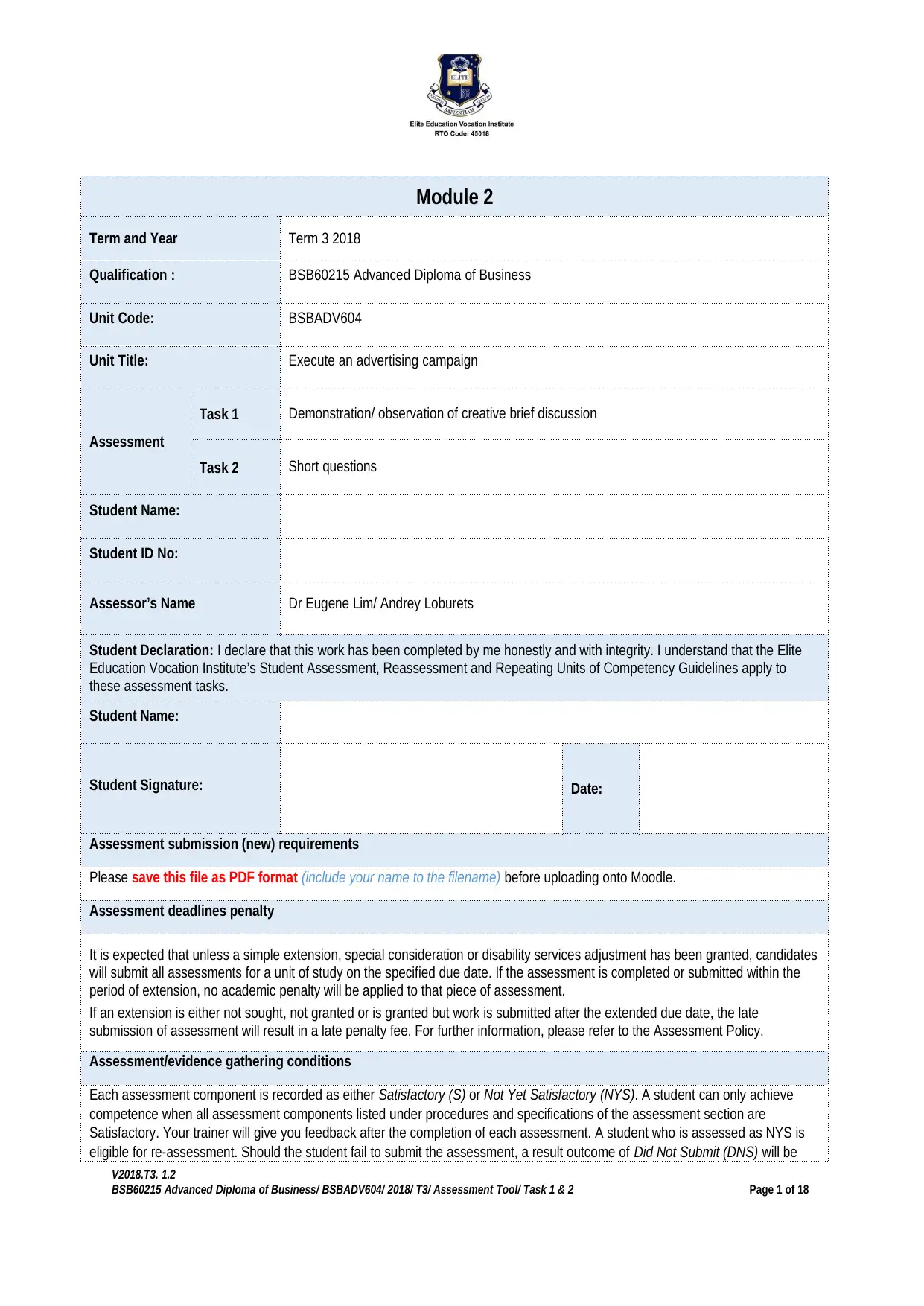
Module 2
Term and Year Term 3 2018
Qualification : BSB60215 Advanced Diploma of Business
Unit Code: BSBADV604
Unit Title: Execute an advertising campaign
Assessment
Task 1 Demonstration/ observation of creative brief discussion
Task 2 Short questions
Student Name:
Student ID No:
Assessor’s Name Dr Eugene Lim/ Andrey Loburets
Student Declaration: I declare that this work has been completed by me honestly and with integrity. I understand that the Elite
Education Vocation Institute’s Student Assessment, Reassessment and Repeating Units of Competency Guidelines apply to
these assessment tasks.
Student Name:
Student Signature: Date:
Assessment submission (new) requirements
Please save this file as PDF format (include your name to the filename) before uploading onto Moodle.
Assessment deadlines penalty
It is expected that unless a simple extension, special consideration or disability services adjustment has been granted, candidates
will submit all assessments for a unit of study on the specified due date. If the assessment is completed or submitted within the
period of extension, no academic penalty will be applied to that piece of assessment.
If an extension is either not sought, not granted or is granted but work is submitted after the extended due date, the late
submission of assessment will result in a late penalty fee. For further information, please refer to the Assessment Policy.
Assessment/evidence gathering conditions
Each assessment component is recorded as either Satisfactory (S) or Not Yet Satisfactory (NYS). A student can only achieve
competence when all assessment components listed under procedures and specifications of the assessment section are
Satisfactory. Your trainer will give you feedback after the completion of each assessment. A student who is assessed as NYS is
eligible for re-assessment. Should the student fail to submit the assessment, a result outcome of Did Not Submit (DNS) will be
V2018.T3. 1.2
BSB60215 Advanced Diploma of Business/ BSBADV604/ 2018/ T3/ Assessment Tool/ Task 1 & 2 Page 1 of 18
Term and Year Term 3 2018
Qualification : BSB60215 Advanced Diploma of Business
Unit Code: BSBADV604
Unit Title: Execute an advertising campaign
Assessment
Task 1 Demonstration/ observation of creative brief discussion
Task 2 Short questions
Student Name:
Student ID No:
Assessor’s Name Dr Eugene Lim/ Andrey Loburets
Student Declaration: I declare that this work has been completed by me honestly and with integrity. I understand that the Elite
Education Vocation Institute’s Student Assessment, Reassessment and Repeating Units of Competency Guidelines apply to
these assessment tasks.
Student Name:
Student Signature: Date:
Assessment submission (new) requirements
Please save this file as PDF format (include your name to the filename) before uploading onto Moodle.
Assessment deadlines penalty
It is expected that unless a simple extension, special consideration or disability services adjustment has been granted, candidates
will submit all assessments for a unit of study on the specified due date. If the assessment is completed or submitted within the
period of extension, no academic penalty will be applied to that piece of assessment.
If an extension is either not sought, not granted or is granted but work is submitted after the extended due date, the late
submission of assessment will result in a late penalty fee. For further information, please refer to the Assessment Policy.
Assessment/evidence gathering conditions
Each assessment component is recorded as either Satisfactory (S) or Not Yet Satisfactory (NYS). A student can only achieve
competence when all assessment components listed under procedures and specifications of the assessment section are
Satisfactory. Your trainer will give you feedback after the completion of each assessment. A student who is assessed as NYS is
eligible for re-assessment. Should the student fail to submit the assessment, a result outcome of Did Not Submit (DNS) will be
V2018.T3. 1.2
BSB60215 Advanced Diploma of Business/ BSBADV604/ 2018/ T3/ Assessment Tool/ Task 1 & 2 Page 1 of 18
Paraphrase This Document
Need a fresh take? Get an instant paraphrase of this document with our AI Paraphraser
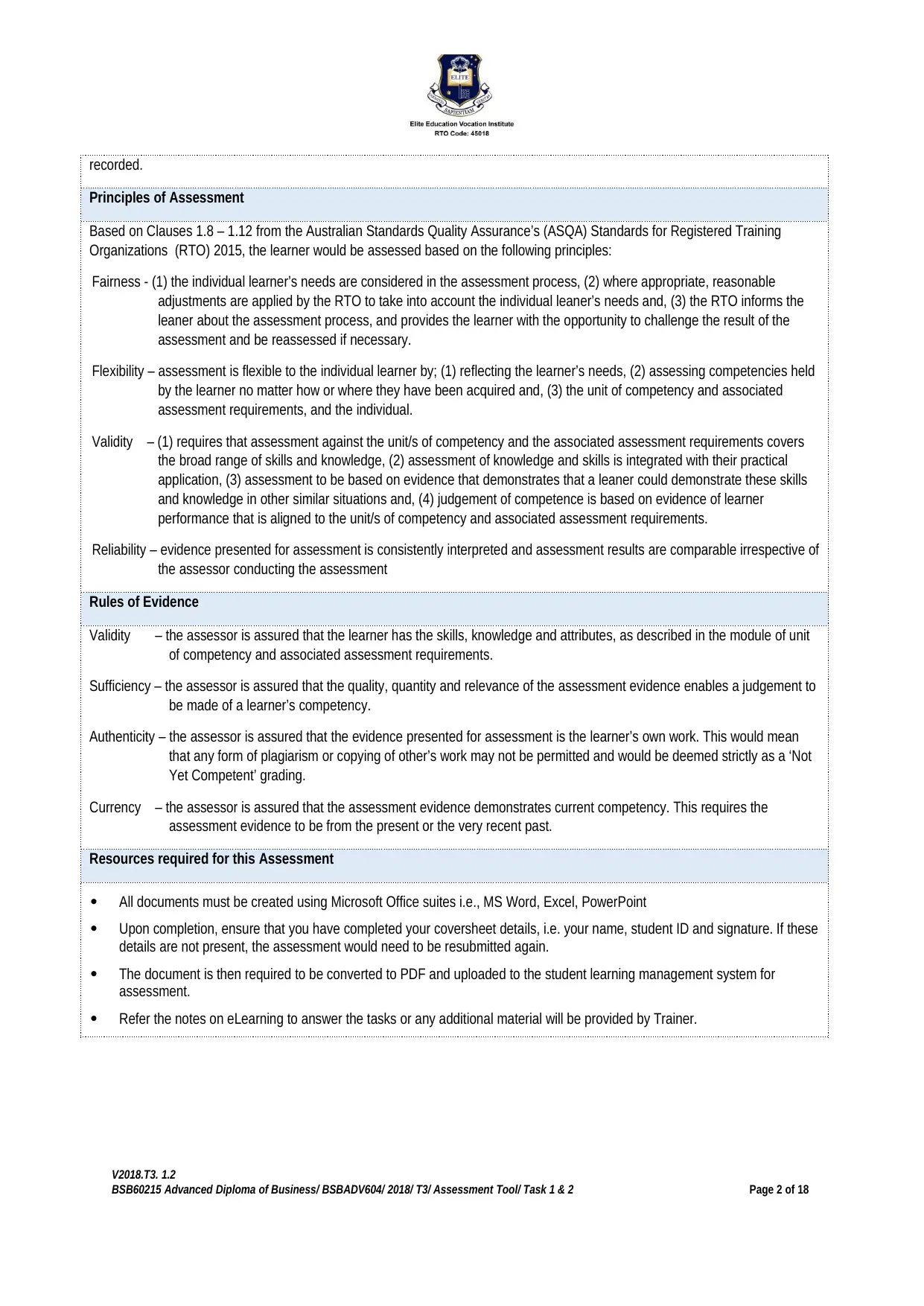
recorded.
Principles of Assessment
Based on Clauses 1.8 – 1.12 from the Australian Standards Quality Assurance’s (ASQA) Standards for Registered Training
Organizations (RTO) 2015, the learner would be assessed based on the following principles:
Fairness - (1) the individual learner’s needs are considered in the assessment process, (2) where appropriate, reasonable
adjustments are applied by the RTO to take into account the individual leaner’s needs and, (3) the RTO informs the
leaner about the assessment process, and provides the learner with the opportunity to challenge the result of the
assessment and be reassessed if necessary.
Flexibility – assessment is flexible to the individual learner by; (1) reflecting the learner’s needs, (2) assessing competencies held
by the learner no matter how or where they have been acquired and, (3) the unit of competency and associated
assessment requirements, and the individual.
Validity – (1) requires that assessment against the unit/s of competency and the associated assessment requirements covers
the broad range of skills and knowledge, (2) assessment of knowledge and skills is integrated with their practical
application, (3) assessment to be based on evidence that demonstrates that a leaner could demonstrate these skills
and knowledge in other similar situations and, (4) judgement of competence is based on evidence of learner
performance that is aligned to the unit/s of competency and associated assessment requirements.
Reliability – evidence presented for assessment is consistently interpreted and assessment results are comparable irrespective of
the assessor conducting the assessment
Rules of Evidence
Validity – the assessor is assured that the learner has the skills, knowledge and attributes, as described in the module of unit
of competency and associated assessment requirements.
Sufficiency – the assessor is assured that the quality, quantity and relevance of the assessment evidence enables a judgement to
be made of a learner’s competency.
Authenticity – the assessor is assured that the evidence presented for assessment is the learner’s own work. This would mean
that any form of plagiarism or copying of other’s work may not be permitted and would be deemed strictly as a ‘Not
Yet Competent’ grading.
Currency – the assessor is assured that the assessment evidence demonstrates current competency. This requires the
assessment evidence to be from the present or the very recent past.
Resources required for this Assessment
All documents must be created using Microsoft Office suites i.e., MS Word, Excel, PowerPoint
Upon completion, ensure that you have completed your coversheet details, i.e. your name, student ID and signature. If these
details are not present, the assessment would need to be resubmitted again.
The document is then required to be converted to PDF and uploaded to the student learning management system for
assessment.
Refer the notes on eLearning to answer the tasks or any additional material will be provided by Trainer.
V2018.T3. 1.2
BSB60215 Advanced Diploma of Business/ BSBADV604/ 2018/ T3/ Assessment Tool/ Task 1 & 2 Page 2 of 18
Principles of Assessment
Based on Clauses 1.8 – 1.12 from the Australian Standards Quality Assurance’s (ASQA) Standards for Registered Training
Organizations (RTO) 2015, the learner would be assessed based on the following principles:
Fairness - (1) the individual learner’s needs are considered in the assessment process, (2) where appropriate, reasonable
adjustments are applied by the RTO to take into account the individual leaner’s needs and, (3) the RTO informs the
leaner about the assessment process, and provides the learner with the opportunity to challenge the result of the
assessment and be reassessed if necessary.
Flexibility – assessment is flexible to the individual learner by; (1) reflecting the learner’s needs, (2) assessing competencies held
by the learner no matter how or where they have been acquired and, (3) the unit of competency and associated
assessment requirements, and the individual.
Validity – (1) requires that assessment against the unit/s of competency and the associated assessment requirements covers
the broad range of skills and knowledge, (2) assessment of knowledge and skills is integrated with their practical
application, (3) assessment to be based on evidence that demonstrates that a leaner could demonstrate these skills
and knowledge in other similar situations and, (4) judgement of competence is based on evidence of learner
performance that is aligned to the unit/s of competency and associated assessment requirements.
Reliability – evidence presented for assessment is consistently interpreted and assessment results are comparable irrespective of
the assessor conducting the assessment
Rules of Evidence
Validity – the assessor is assured that the learner has the skills, knowledge and attributes, as described in the module of unit
of competency and associated assessment requirements.
Sufficiency – the assessor is assured that the quality, quantity and relevance of the assessment evidence enables a judgement to
be made of a learner’s competency.
Authenticity – the assessor is assured that the evidence presented for assessment is the learner’s own work. This would mean
that any form of plagiarism or copying of other’s work may not be permitted and would be deemed strictly as a ‘Not
Yet Competent’ grading.
Currency – the assessor is assured that the assessment evidence demonstrates current competency. This requires the
assessment evidence to be from the present or the very recent past.
Resources required for this Assessment
All documents must be created using Microsoft Office suites i.e., MS Word, Excel, PowerPoint
Upon completion, ensure that you have completed your coversheet details, i.e. your name, student ID and signature. If these
details are not present, the assessment would need to be resubmitted again.
The document is then required to be converted to PDF and uploaded to the student learning management system for
assessment.
Refer the notes on eLearning to answer the tasks or any additional material will be provided by Trainer.
V2018.T3. 1.2
BSB60215 Advanced Diploma of Business/ BSBADV604/ 2018/ T3/ Assessment Tool/ Task 1 & 2 Page 2 of 18
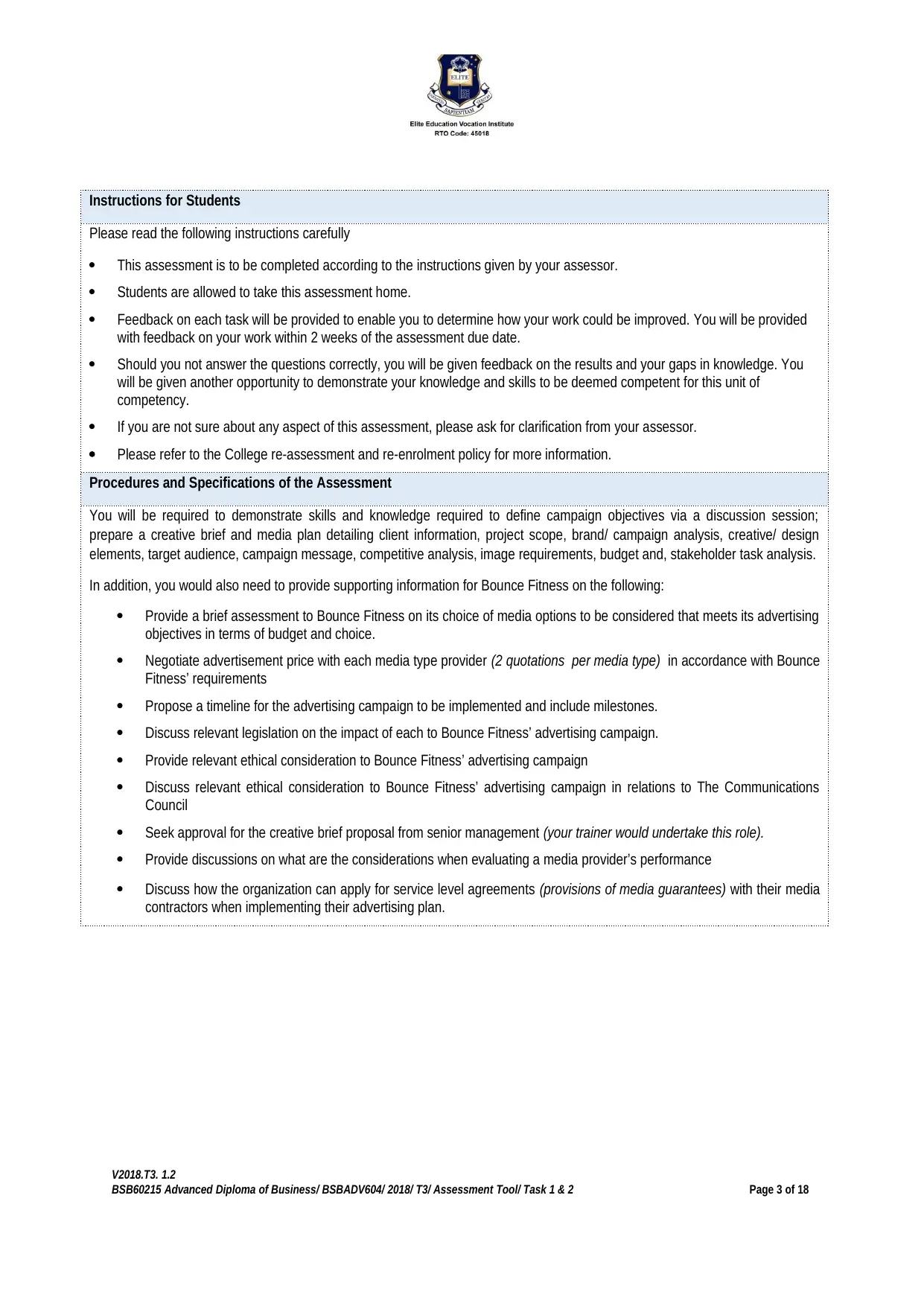
Instructions for Students
Please read the following instructions carefully
This assessment is to be completed according to the instructions given by your assessor.
Students are allowed to take this assessment home.
Feedback on each task will be provided to enable you to determine how your work could be improved. You will be provided
with feedback on your work within 2 weeks of the assessment due date.
Should you not answer the questions correctly, you will be given feedback on the results and your gaps in knowledge. You
will be given another opportunity to demonstrate your knowledge and skills to be deemed competent for this unit of
competency.
If you are not sure about any aspect of this assessment, please ask for clarification from your assessor.
Please refer to the College re-assessment and re-enrolment policy for more information.
Procedures and Specifications of the Assessment
You will be required to demonstrate skills and knowledge required to define campaign objectives via a discussion session;
prepare a creative brief and media plan detailing client information, project scope, brand/ campaign analysis, creative/ design
elements, target audience, campaign message, competitive analysis, image requirements, budget and, stakeholder task analysis.
In addition, you would also need to provide supporting information for Bounce Fitness on the following:
Provide a brief assessment to Bounce Fitness on its choice of media options to be considered that meets its advertising
objectives in terms of budget and choice.
Negotiate advertisement price with each media type provider (2 quotations per media type) in accordance with Bounce
Fitness’ requirements
Propose a timeline for the advertising campaign to be implemented and include milestones.
Discuss relevant legislation on the impact of each to Bounce Fitness’ advertising campaign.
Provide relevant ethical consideration to Bounce Fitness’ advertising campaign
Discuss relevant ethical consideration to Bounce Fitness’ advertising campaign in relations to The Communications
Council
Seek approval for the creative brief proposal from senior management (your trainer would undertake this role).
Provide discussions on what are the considerations when evaluating a media provider’s performance
Discuss how the organization can apply for service level agreements (provisions of media guarantees) with their media
contractors when implementing their advertising plan.
V2018.T3. 1.2
BSB60215 Advanced Diploma of Business/ BSBADV604/ 2018/ T3/ Assessment Tool/ Task 1 & 2 Page 3 of 18
Please read the following instructions carefully
This assessment is to be completed according to the instructions given by your assessor.
Students are allowed to take this assessment home.
Feedback on each task will be provided to enable you to determine how your work could be improved. You will be provided
with feedback on your work within 2 weeks of the assessment due date.
Should you not answer the questions correctly, you will be given feedback on the results and your gaps in knowledge. You
will be given another opportunity to demonstrate your knowledge and skills to be deemed competent for this unit of
competency.
If you are not sure about any aspect of this assessment, please ask for clarification from your assessor.
Please refer to the College re-assessment and re-enrolment policy for more information.
Procedures and Specifications of the Assessment
You will be required to demonstrate skills and knowledge required to define campaign objectives via a discussion session;
prepare a creative brief and media plan detailing client information, project scope, brand/ campaign analysis, creative/ design
elements, target audience, campaign message, competitive analysis, image requirements, budget and, stakeholder task analysis.
In addition, you would also need to provide supporting information for Bounce Fitness on the following:
Provide a brief assessment to Bounce Fitness on its choice of media options to be considered that meets its advertising
objectives in terms of budget and choice.
Negotiate advertisement price with each media type provider (2 quotations per media type) in accordance with Bounce
Fitness’ requirements
Propose a timeline for the advertising campaign to be implemented and include milestones.
Discuss relevant legislation on the impact of each to Bounce Fitness’ advertising campaign.
Provide relevant ethical consideration to Bounce Fitness’ advertising campaign
Discuss relevant ethical consideration to Bounce Fitness’ advertising campaign in relations to The Communications
Council
Seek approval for the creative brief proposal from senior management (your trainer would undertake this role).
Provide discussions on what are the considerations when evaluating a media provider’s performance
Discuss how the organization can apply for service level agreements (provisions of media guarantees) with their media
contractors when implementing their advertising plan.
V2018.T3. 1.2
BSB60215 Advanced Diploma of Business/ BSBADV604/ 2018/ T3/ Assessment Tool/ Task 1 & 2 Page 3 of 18
⊘ This is a preview!⊘
Do you want full access?
Subscribe today to unlock all pages.

Trusted by 1+ million students worldwide
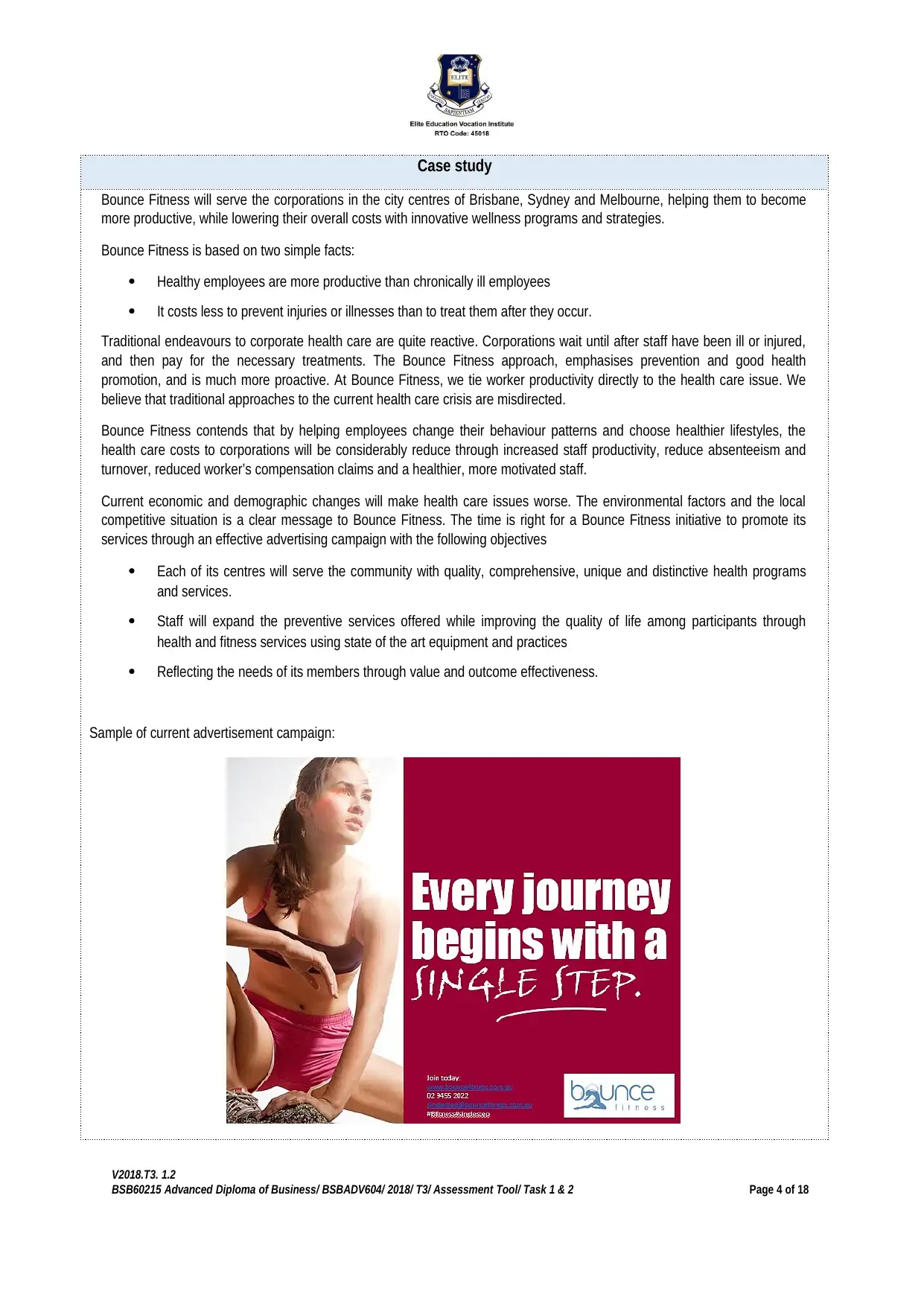
Case study
Bounce Fitness will serve the corporations in the city centres of Brisbane, Sydney and Melbourne, helping them to become
more productive, while lowering their overall costs with innovative wellness programs and strategies.
Bounce Fitness is based on two simple facts:
Healthy employees are more productive than chronically ill employees
It costs less to prevent injuries or illnesses than to treat them after they occur.
Traditional endeavours to corporate health care are quite reactive. Corporations wait until after staff have been ill or injured,
and then pay for the necessary treatments. The Bounce Fitness approach, emphasises prevention and good health
promotion, and is much more proactive. At Bounce Fitness, we tie worker productivity directly to the health care issue. We
believe that traditional approaches to the current health care crisis are misdirected.
Bounce Fitness contends that by helping employees change their behaviour patterns and choose healthier lifestyles, the
health care costs to corporations will be considerably reduce through increased staff productivity, reduce absenteeism and
turnover, reduced worker’s compensation claims and a healthier, more motivated staff.
Current economic and demographic changes will make health care issues worse. The environmental factors and the local
competitive situation is a clear message to Bounce Fitness. The time is right for a Bounce Fitness initiative to promote its
services through an effective advertising campaign with the following objectives
Each of its centres will serve the community with quality, comprehensive, unique and distinctive health programs
and services.
Staff will expand the preventive services offered while improving the quality of life among participants through
health and fitness services using state of the art equipment and practices
Reflecting the needs of its members through value and outcome effectiveness.
Sample of current advertisement campaign:
V2018.T3. 1.2
BSB60215 Advanced Diploma of Business/ BSBADV604/ 2018/ T3/ Assessment Tool/ Task 1 & 2 Page 4 of 18
Bounce Fitness will serve the corporations in the city centres of Brisbane, Sydney and Melbourne, helping them to become
more productive, while lowering their overall costs with innovative wellness programs and strategies.
Bounce Fitness is based on two simple facts:
Healthy employees are more productive than chronically ill employees
It costs less to prevent injuries or illnesses than to treat them after they occur.
Traditional endeavours to corporate health care are quite reactive. Corporations wait until after staff have been ill or injured,
and then pay for the necessary treatments. The Bounce Fitness approach, emphasises prevention and good health
promotion, and is much more proactive. At Bounce Fitness, we tie worker productivity directly to the health care issue. We
believe that traditional approaches to the current health care crisis are misdirected.
Bounce Fitness contends that by helping employees change their behaviour patterns and choose healthier lifestyles, the
health care costs to corporations will be considerably reduce through increased staff productivity, reduce absenteeism and
turnover, reduced worker’s compensation claims and a healthier, more motivated staff.
Current economic and demographic changes will make health care issues worse. The environmental factors and the local
competitive situation is a clear message to Bounce Fitness. The time is right for a Bounce Fitness initiative to promote its
services through an effective advertising campaign with the following objectives
Each of its centres will serve the community with quality, comprehensive, unique and distinctive health programs
and services.
Staff will expand the preventive services offered while improving the quality of life among participants through
health and fitness services using state of the art equipment and practices
Reflecting the needs of its members through value and outcome effectiveness.
Sample of current advertisement campaign:
V2018.T3. 1.2
BSB60215 Advanced Diploma of Business/ BSBADV604/ 2018/ T3/ Assessment Tool/ Task 1 & 2 Page 4 of 18
Paraphrase This Document
Need a fresh take? Get an instant paraphrase of this document with our AI Paraphraser
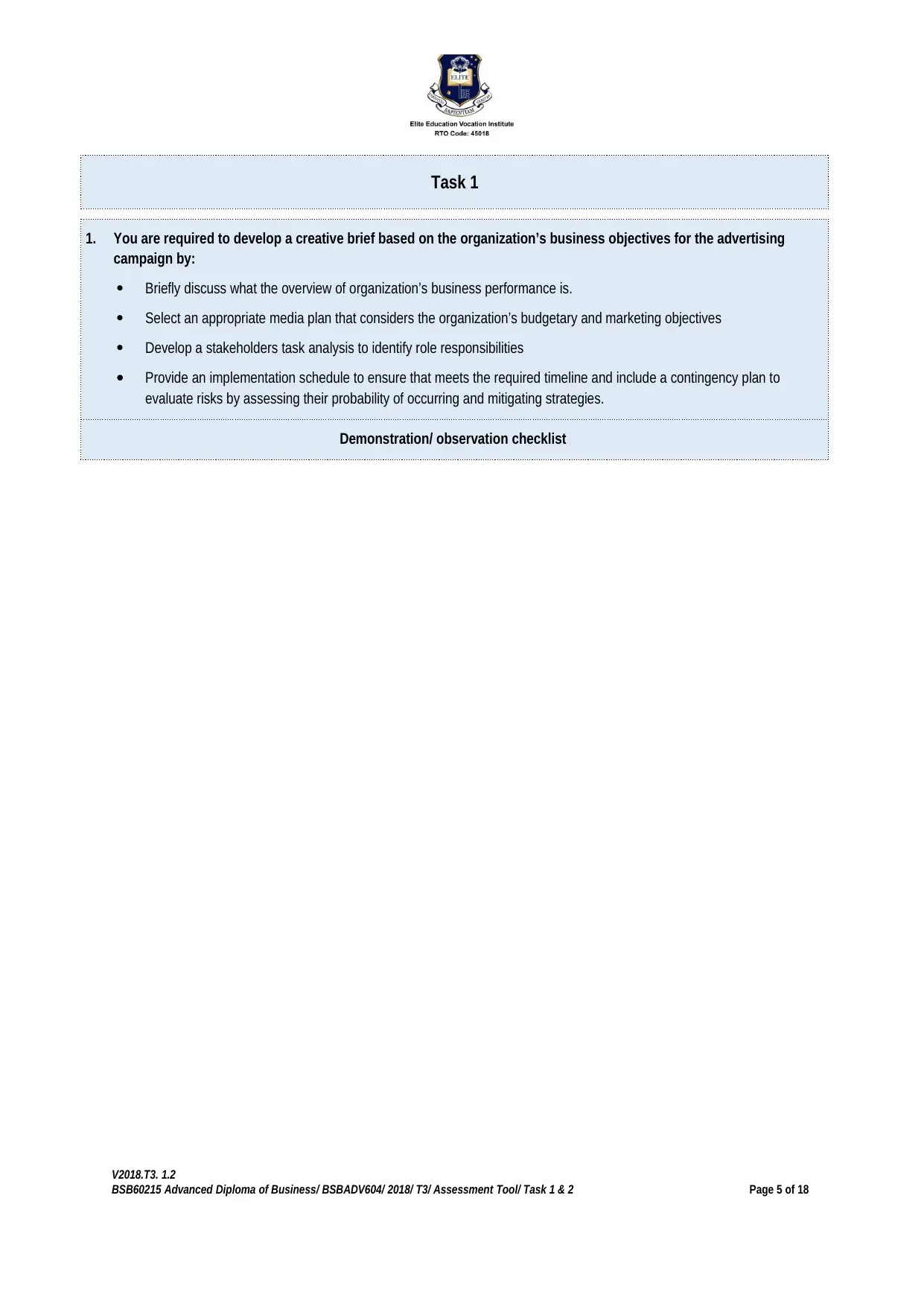
Task 1
1. You are required to develop a creative brief based on the organization’s business objectives for the advertising
campaign by:
Briefly discuss what the overview of organization’s business performance is.
Select an appropriate media plan that considers the organization’s budgetary and marketing objectives
Develop a stakeholders task analysis to identify role responsibilities
Provide an implementation schedule to ensure that meets the required timeline and include a contingency plan to
evaluate risks by assessing their probability of occurring and mitigating strategies.
Demonstration/ observation checklist
V2018.T3. 1.2
BSB60215 Advanced Diploma of Business/ BSBADV604/ 2018/ T3/ Assessment Tool/ Task 1 & 2 Page 5 of 18
1. You are required to develop a creative brief based on the organization’s business objectives for the advertising
campaign by:
Briefly discuss what the overview of organization’s business performance is.
Select an appropriate media plan that considers the organization’s budgetary and marketing objectives
Develop a stakeholders task analysis to identify role responsibilities
Provide an implementation schedule to ensure that meets the required timeline and include a contingency plan to
evaluate risks by assessing their probability of occurring and mitigating strategies.
Demonstration/ observation checklist
V2018.T3. 1.2
BSB60215 Advanced Diploma of Business/ BSBADV604/ 2018/ T3/ Assessment Tool/ Task 1 & 2 Page 5 of 18

Candidate’s name
Assessor’s name Dr Eugene Lim/ Andrey Loburets
Work activity Creative brief and media plan proposal
Date
Creative brief analysis and media plan
1.1 Client
Client’s name Bounce Fitness
Campaign’s name
(based on your choice) Bounce Fitness Advertisement Campaign
Description of the
advertising
campaign
A wellness strategy is a long-term effort, combining both health-promotion and exercise-
related activities designed to facilitate positive lifestyle changes in members of a
company’s work force.
Prepared by
(student’s name)
1.2 Project
Marketing
objectives
(Please refer to Creative
Brief)
Increasing 10 percent yearly sales
Increasing market penetration in Australia every quarter
Cultivating and promoting the image of the company as a wellness program provider.
Objective of the
campaign
(Please refer to Creative
Brief)
Increase the sales of the company while building a loyal customer base and increasing brand
awareness
V2018.T3. 1.2
BSB60215 Advanced Diploma of Business/ BSBADV604/ 2018/ T3/ Assessment Tool/ Task 1 & 2 Page 6 of 18
Assessor’s name Dr Eugene Lim/ Andrey Loburets
Work activity Creative brief and media plan proposal
Date
Creative brief analysis and media plan
1.1 Client
Client’s name Bounce Fitness
Campaign’s name
(based on your choice) Bounce Fitness Advertisement Campaign
Description of the
advertising
campaign
A wellness strategy is a long-term effort, combining both health-promotion and exercise-
related activities designed to facilitate positive lifestyle changes in members of a
company’s work force.
Prepared by
(student’s name)
1.2 Project
Marketing
objectives
(Please refer to Creative
Brief)
Increasing 10 percent yearly sales
Increasing market penetration in Australia every quarter
Cultivating and promoting the image of the company as a wellness program provider.
Objective of the
campaign
(Please refer to Creative
Brief)
Increase the sales of the company while building a loyal customer base and increasing brand
awareness
V2018.T3. 1.2
BSB60215 Advanced Diploma of Business/ BSBADV604/ 2018/ T3/ Assessment Tool/ Task 1 & 2 Page 6 of 18
⊘ This is a preview!⊘
Do you want full access?
Subscribe today to unlock all pages.

Trusted by 1+ million students worldwide

1.3 Current campaign analysis
Positive aspects
(Refer to M1 under
performance metrics)
Highly talented workforce who is dedicated and encouraged to assist the customers and
accurate forecasting of sales targets
Negative aspects
(Refer to M1 under
performance metrics)
Lack of brand awareness and reliance on traditional media sources for advertisement which
increases overall costs without being effective
1.4 Creative/
design elements
What are the
fundamental
creative/ design
components of the
project?
Focus on needs of customers to deliver a convenient program
1.5 Target audience
Primary
demographic
(Refer to Creative
Brief)
Customers who are living in Brisbane, Sydney and Melbourne area between the income range of
$38,000-$75,000
Secondary
demographic
(Refer to Creative
Brief)
Customers utilising fringe benefits from their employers
Desired reaction
(what actions do you
which your market to
take?)
Growth in the number of people who are encouraged to join a gym to focus on their fitness
1.6 Campaign message Project tone/ keys
to success
(Please refer to
Creative Brief)
Reliance on a highly dedicated workforce and effective marketing campaign to build a strong
customer base
Tag line
(Based on your
advertisement created
in M1)
Turn Fat into FIT and be an Inspiration for Others
V2018.T3. 1.2
BSB60215 Advanced Diploma of Business/ BSBADV604/ 2018/ T3/ Assessment Tool/ Task 1 & 2 Page 7 of 18
Positive aspects
(Refer to M1 under
performance metrics)
Highly talented workforce who is dedicated and encouraged to assist the customers and
accurate forecasting of sales targets
Negative aspects
(Refer to M1 under
performance metrics)
Lack of brand awareness and reliance on traditional media sources for advertisement which
increases overall costs without being effective
1.4 Creative/
design elements
What are the
fundamental
creative/ design
components of the
project?
Focus on needs of customers to deliver a convenient program
1.5 Target audience
Primary
demographic
(Refer to Creative
Brief)
Customers who are living in Brisbane, Sydney and Melbourne area between the income range of
$38,000-$75,000
Secondary
demographic
(Refer to Creative
Brief)
Customers utilising fringe benefits from their employers
Desired reaction
(what actions do you
which your market to
take?)
Growth in the number of people who are encouraged to join a gym to focus on their fitness
1.6 Campaign message Project tone/ keys
to success
(Please refer to
Creative Brief)
Reliance on a highly dedicated workforce and effective marketing campaign to build a strong
customer base
Tag line
(Based on your
advertisement created
in M1)
Turn Fat into FIT and be an Inspiration for Others
V2018.T3. 1.2
BSB60215 Advanced Diploma of Business/ BSBADV604/ 2018/ T3/ Assessment Tool/ Task 1 & 2 Page 7 of 18
Paraphrase This Document
Need a fresh take? Get an instant paraphrase of this document with our AI Paraphraser
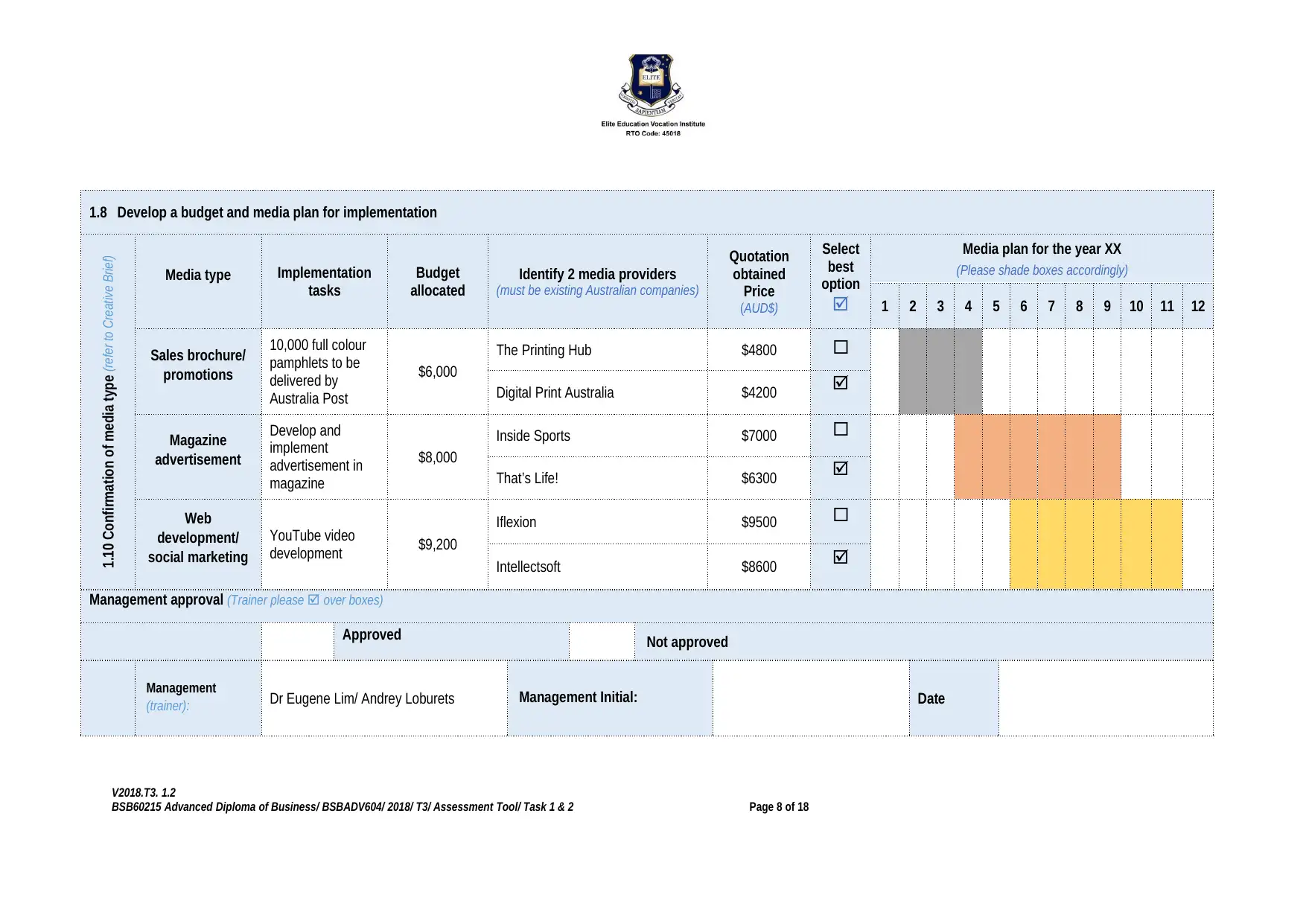
1.8 Develop a budget and media plan for implementation
1.10 Confirmation of media type (refer to Creative Brief)
Media type Implementation
tasks
Budget
allocated
Identify 2 media providers
(must be existing Australian companies)
Quotation
obtained
Price
(AUD$)
Select
best
option
Media plan for the year XX
(Please shade boxes accordingly)
1 2 3 4 5 6 7 8 9 10 11 12
Sales brochure/
promotions
10,000 full colour
pamphlets to be
delivered by
Australia Post
$6,000
The Printing Hub $4800
Digital Print Australia $4200
Magazine
advertisement
Develop and
implement
advertisement in
magazine
$8,000
Inside Sports $7000
That’s Life! $6300
Web
development/
social marketing
YouTube video
development $9,200
Iflexion $9500
Intellectsoft $8600
Management approval (Trainer please over boxes)
Approved Not approved
Management
(trainer): Dr Eugene Lim/ Andrey Loburets Management Initial: Date
V2018.T3. 1.2
BSB60215 Advanced Diploma of Business/ BSBADV604/ 2018/ T3/ Assessment Tool/ Task 1 & 2 Page 8 of 18
1.10 Confirmation of media type (refer to Creative Brief)
Media type Implementation
tasks
Budget
allocated
Identify 2 media providers
(must be existing Australian companies)
Quotation
obtained
Price
(AUD$)
Select
best
option
Media plan for the year XX
(Please shade boxes accordingly)
1 2 3 4 5 6 7 8 9 10 11 12
Sales brochure/
promotions
10,000 full colour
pamphlets to be
delivered by
Australia Post
$6,000
The Printing Hub $4800
Digital Print Australia $4200
Magazine
advertisement
Develop and
implement
advertisement in
magazine
$8,000
Inside Sports $7000
That’s Life! $6300
Web
development/
social marketing
YouTube video
development $9,200
Iflexion $9500
Intellectsoft $8600
Management approval (Trainer please over boxes)
Approved Not approved
Management
(trainer): Dr Eugene Lim/ Andrey Loburets Management Initial: Date
V2018.T3. 1.2
BSB60215 Advanced Diploma of Business/ BSBADV604/ 2018/ T3/ Assessment Tool/ Task 1 & 2 Page 8 of 18
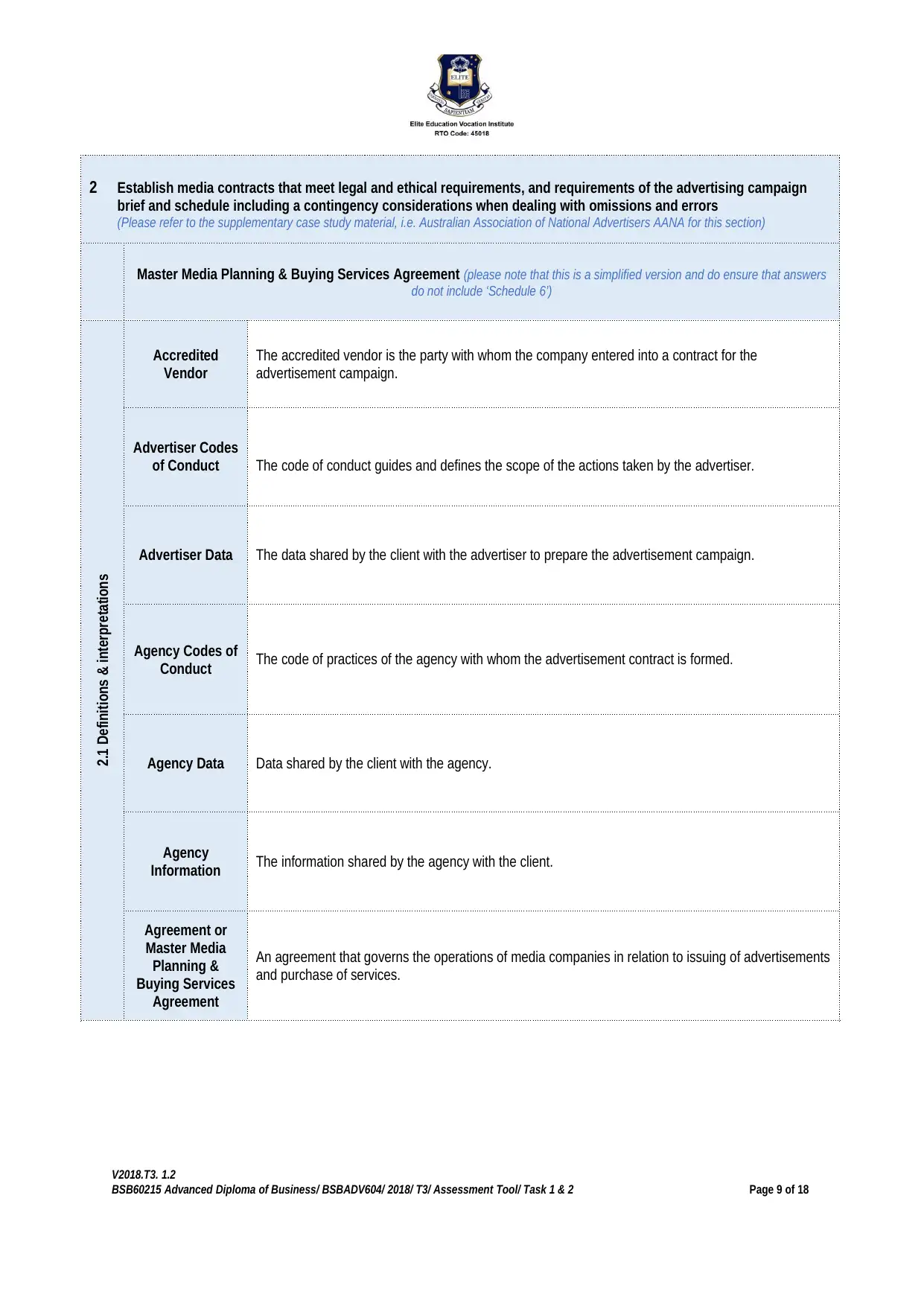
2 Establish media contracts that meet legal and ethical requirements, and requirements of the advertising campaign
brief and schedule including a contingency considerations when dealing with omissions and errors
(Please refer to the supplementary case study material, i.e. Australian Association of National Advertisers AANA for this section)
Master Media Planning & Buying Services Agreement (please note that this is a simplified version and do ensure that answers
do not include ‘Schedule 6’)
2.1 Definitions & interpretations
Accredited
Vendor
The accredited vendor is the party with whom the company entered into a contract for the
advertisement campaign.
Advertiser Codes
of Conduct The code of conduct guides and defines the scope of the actions taken by the advertiser.
Advertiser Data The data shared by the client with the advertiser to prepare the advertisement campaign.
Agency Codes of
Conduct The code of practices of the agency with whom the advertisement contract is formed.
Agency Data Data shared by the client with the agency.
Agency
Information The information shared by the agency with the client.
Agreement or
Master Media
Planning &
Buying Services
Agreement
An agreement that governs the operations of media companies in relation to issuing of advertisements
and purchase of services.
V2018.T3. 1.2
BSB60215 Advanced Diploma of Business/ BSBADV604/ 2018/ T3/ Assessment Tool/ Task 1 & 2 Page 9 of 18
brief and schedule including a contingency considerations when dealing with omissions and errors
(Please refer to the supplementary case study material, i.e. Australian Association of National Advertisers AANA for this section)
Master Media Planning & Buying Services Agreement (please note that this is a simplified version and do ensure that answers
do not include ‘Schedule 6’)
2.1 Definitions & interpretations
Accredited
Vendor
The accredited vendor is the party with whom the company entered into a contract for the
advertisement campaign.
Advertiser Codes
of Conduct The code of conduct guides and defines the scope of the actions taken by the advertiser.
Advertiser Data The data shared by the client with the advertiser to prepare the advertisement campaign.
Agency Codes of
Conduct The code of practices of the agency with whom the advertisement contract is formed.
Agency Data Data shared by the client with the agency.
Agency
Information The information shared by the agency with the client.
Agreement or
Master Media
Planning &
Buying Services
Agreement
An agreement that governs the operations of media companies in relation to issuing of advertisements
and purchase of services.
V2018.T3. 1.2
BSB60215 Advanced Diploma of Business/ BSBADV604/ 2018/ T3/ Assessment Tool/ Task 1 & 2 Page 9 of 18
⊘ This is a preview!⊘
Do you want full access?
Subscribe today to unlock all pages.

Trusted by 1+ million students worldwide

2.1 Definitions & interpretations (cont.)
Annual Scope of
Work The scope within which the advertiser can develop the advertisement campaign.
Applicable Laws The guidelines issued by regulatory authorities such as AANA, ACMA and others to ensure that
companies comply with legal and ethical provisions.
Conflicts of
Interest
The failure of the service provider to comply with the policies or the failure of the company to
comply with the policies of the advertisers.
Confidential
Information
The confidential data shared by the company with the advertiser to prepare the advertisement
campaign.
Corporations Act The Corporations Act 2001 (Cth) provides various provisions which governs the actions of
companies operating in Australia which advertising companies also have to comply with.
Deliverables The deliverables are referred to the tangible or intangible goods or services produced by the
advertiser which is delivered to the customers.
Dispute The dispute arises between parties if any terms of the contract is breached or non-fulfilled by
them.
Force Majeure It is referred to unavoidable accident without occurred without the actions of either parties of the
contract and it is not avoided by them.
V2018.T3. 1.2
BSB60215 Advanced Diploma of Business/ BSBADV604/ 2018/ T3/ Assessment Tool/ Task 1 & 2 Page 10 of
18
Annual Scope of
Work The scope within which the advertiser can develop the advertisement campaign.
Applicable Laws The guidelines issued by regulatory authorities such as AANA, ACMA and others to ensure that
companies comply with legal and ethical provisions.
Conflicts of
Interest
The failure of the service provider to comply with the policies or the failure of the company to
comply with the policies of the advertisers.
Confidential
Information
The confidential data shared by the company with the advertiser to prepare the advertisement
campaign.
Corporations Act The Corporations Act 2001 (Cth) provides various provisions which governs the actions of
companies operating in Australia which advertising companies also have to comply with.
Deliverables The deliverables are referred to the tangible or intangible goods or services produced by the
advertiser which is delivered to the customers.
Dispute The dispute arises between parties if any terms of the contract is breached or non-fulfilled by
them.
Force Majeure It is referred to unavoidable accident without occurred without the actions of either parties of the
contract and it is not avoided by them.
V2018.T3. 1.2
BSB60215 Advanced Diploma of Business/ BSBADV604/ 2018/ T3/ Assessment Tool/ Task 1 & 2 Page 10 of
18
Paraphrase This Document
Need a fresh take? Get an instant paraphrase of this document with our AI Paraphraser
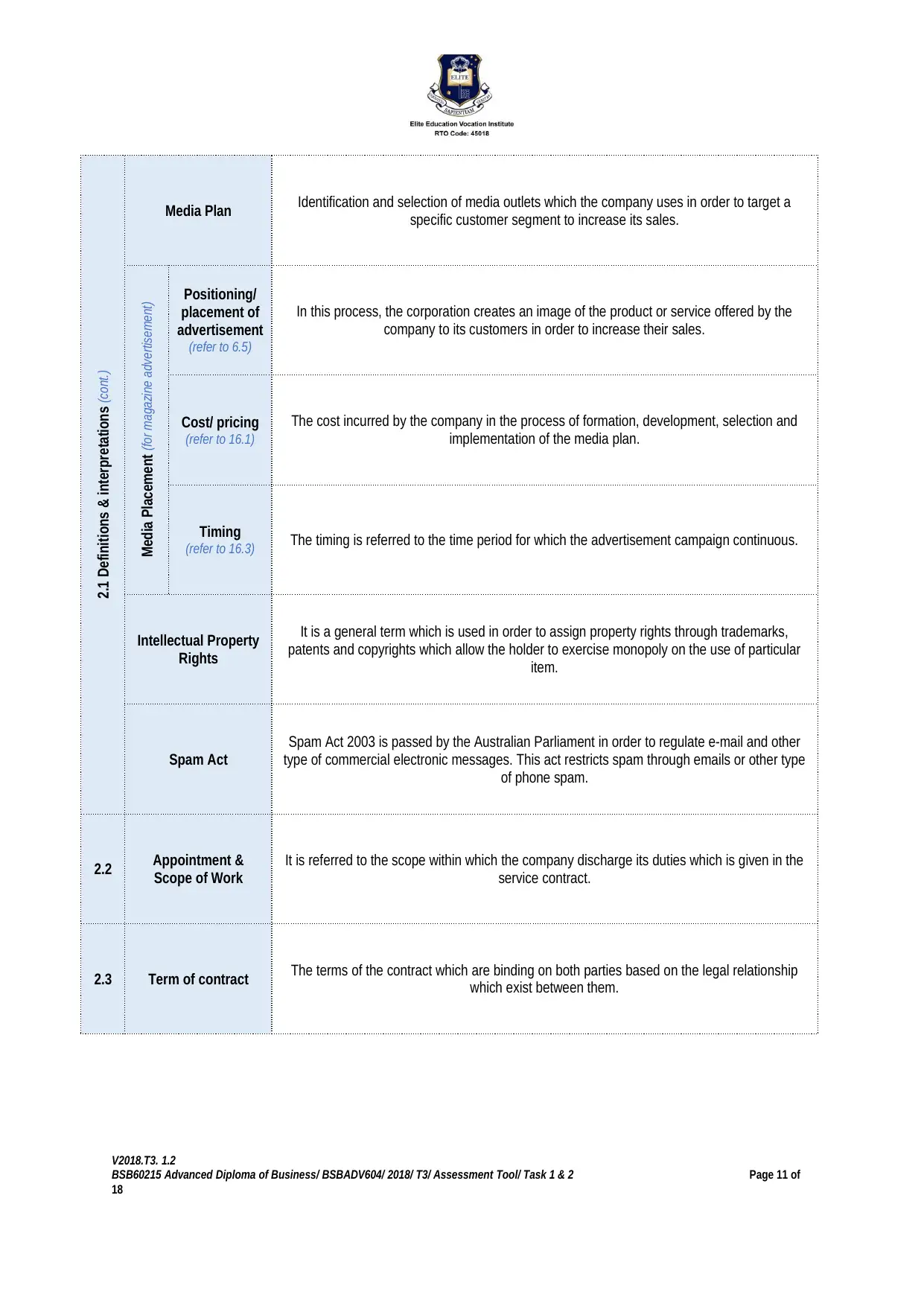
2.1 Definitions & interpretations (cont.)
Media Plan Identification and selection of media outlets which the company uses in order to target a
specific customer segment to increase its sales.
Media Placement (for magazine advertisement) Positioning/
placement of
advertisement
(refer to 6.5)
In this process, the corporation creates an image of the product or service offered by the
company to its customers in order to increase their sales.
Cost/ pricing
(refer to 16.1)
The cost incurred by the company in the process of formation, development, selection and
implementation of the media plan.
Timing
(refer to 16.3) The timing is referred to the time period for which the advertisement campaign continuous.
Intellectual Property
Rights
It is a general term which is used in order to assign property rights through trademarks,
patents and copyrights which allow the holder to exercise monopoly on the use of particular
item.
Spam Act
Spam Act 2003 is passed by the Australian Parliament in order to regulate e-mail and other
type of commercial electronic messages. This act restricts spam through emails or other type
of phone spam.
2.2 Appointment &
Scope of Work
It is referred to the scope within which the company discharge its duties which is given in the
service contract.
2.3 Term of contract The terms of the contract which are binding on both parties based on the legal relationship
which exist between them.
V2018.T3. 1.2
BSB60215 Advanced Diploma of Business/ BSBADV604/ 2018/ T3/ Assessment Tool/ Task 1 & 2 Page 11 of
18
Media Plan Identification and selection of media outlets which the company uses in order to target a
specific customer segment to increase its sales.
Media Placement (for magazine advertisement) Positioning/
placement of
advertisement
(refer to 6.5)
In this process, the corporation creates an image of the product or service offered by the
company to its customers in order to increase their sales.
Cost/ pricing
(refer to 16.1)
The cost incurred by the company in the process of formation, development, selection and
implementation of the media plan.
Timing
(refer to 16.3) The timing is referred to the time period for which the advertisement campaign continuous.
Intellectual Property
Rights
It is a general term which is used in order to assign property rights through trademarks,
patents and copyrights which allow the holder to exercise monopoly on the use of particular
item.
Spam Act
Spam Act 2003 is passed by the Australian Parliament in order to regulate e-mail and other
type of commercial electronic messages. This act restricts spam through emails or other type
of phone spam.
2.2 Appointment &
Scope of Work
It is referred to the scope within which the company discharge its duties which is given in the
service contract.
2.3 Term of contract The terms of the contract which are binding on both parties based on the legal relationship
which exist between them.
V2018.T3. 1.2
BSB60215 Advanced Diploma of Business/ BSBADV604/ 2018/ T3/ Assessment Tool/ Task 1 & 2 Page 11 of
18
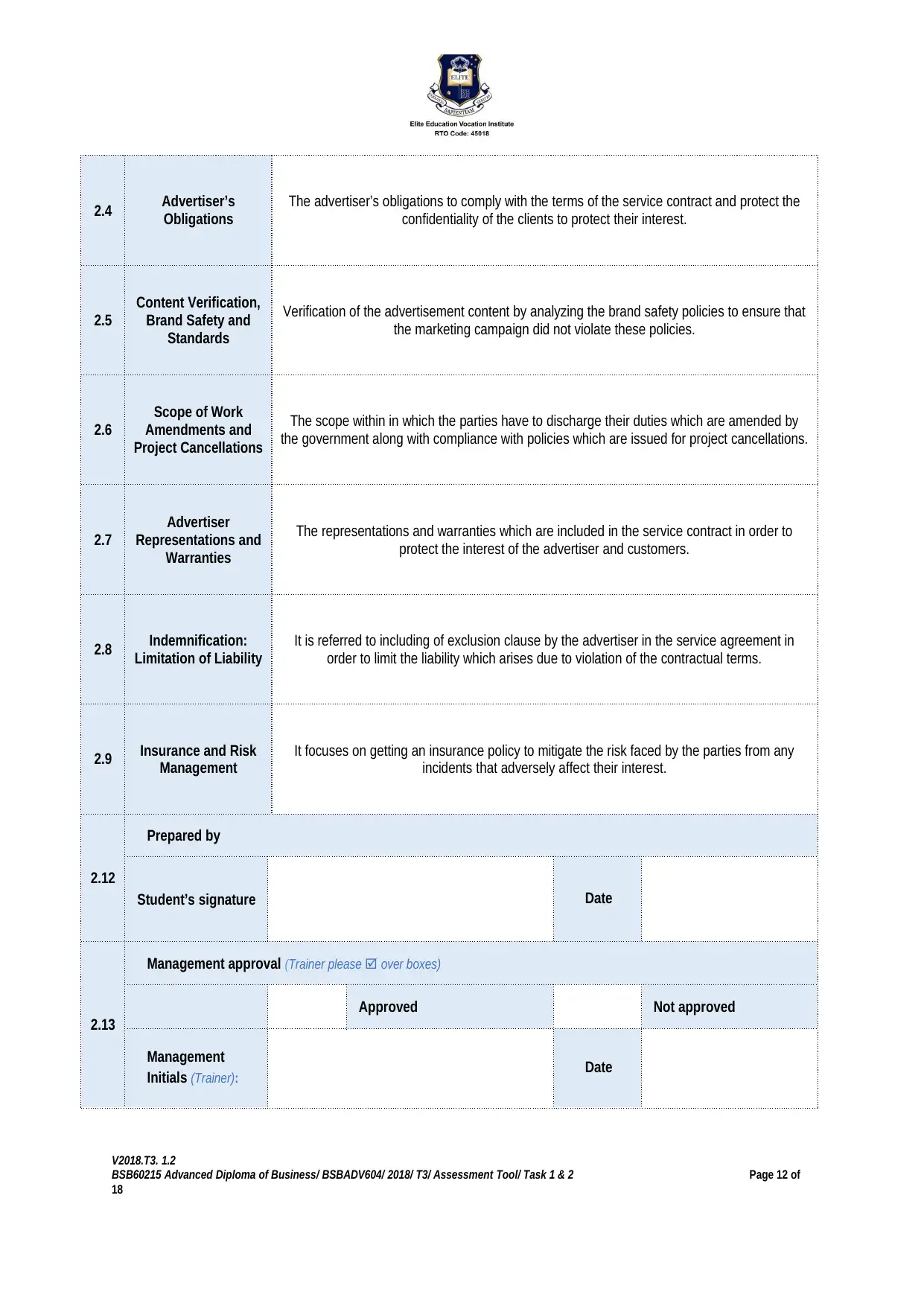
2.4 Advertiser’s
Obligations
The advertiser’s obligations to comply with the terms of the service contract and protect the
confidentiality of the clients to protect their interest.
2.5
Content Verification,
Brand Safety and
Standards
Verification of the advertisement content by analyzing the brand safety policies to ensure that
the marketing campaign did not violate these policies.
2.6
Scope of Work
Amendments and
Project Cancellations
The scope within in which the parties have to discharge their duties which are amended by
the government along with compliance with policies which are issued for project cancellations.
2.7
Advertiser
Representations and
Warranties
The representations and warranties which are included in the service contract in order to
protect the interest of the advertiser and customers.
2.8 Indemnification:
Limitation of Liability
It is referred to including of exclusion clause by the advertiser in the service agreement in
order to limit the liability which arises due to violation of the contractual terms.
2.9 Insurance and Risk
Management
It focuses on getting an insurance policy to mitigate the risk faced by the parties from any
incidents that adversely affect their interest.
2.12
Prepared by
Student’s signature Date
2.13
Management approval (Trainer please over boxes)
Approved Not approved
Management
Initials (Trainer): Date
V2018.T3. 1.2
BSB60215 Advanced Diploma of Business/ BSBADV604/ 2018/ T3/ Assessment Tool/ Task 1 & 2 Page 12 of
18
Obligations
The advertiser’s obligations to comply with the terms of the service contract and protect the
confidentiality of the clients to protect their interest.
2.5
Content Verification,
Brand Safety and
Standards
Verification of the advertisement content by analyzing the brand safety policies to ensure that
the marketing campaign did not violate these policies.
2.6
Scope of Work
Amendments and
Project Cancellations
The scope within in which the parties have to discharge their duties which are amended by
the government along with compliance with policies which are issued for project cancellations.
2.7
Advertiser
Representations and
Warranties
The representations and warranties which are included in the service contract in order to
protect the interest of the advertiser and customers.
2.8 Indemnification:
Limitation of Liability
It is referred to including of exclusion clause by the advertiser in the service agreement in
order to limit the liability which arises due to violation of the contractual terms.
2.9 Insurance and Risk
Management
It focuses on getting an insurance policy to mitigate the risk faced by the parties from any
incidents that adversely affect their interest.
2.12
Prepared by
Student’s signature Date
2.13
Management approval (Trainer please over boxes)
Approved Not approved
Management
Initials (Trainer): Date
V2018.T3. 1.2
BSB60215 Advanced Diploma of Business/ BSBADV604/ 2018/ T3/ Assessment Tool/ Task 1 & 2 Page 12 of
18
⊘ This is a preview!⊘
Do you want full access?
Subscribe today to unlock all pages.

Trusted by 1+ million students worldwide
1 out of 18
Related Documents
Your All-in-One AI-Powered Toolkit for Academic Success.
+13062052269
info@desklib.com
Available 24*7 on WhatsApp / Email
![[object Object]](/_next/static/media/star-bottom.7253800d.svg)
Unlock your academic potential
Copyright © 2020–2025 A2Z Services. All Rights Reserved. Developed and managed by ZUCOL.




